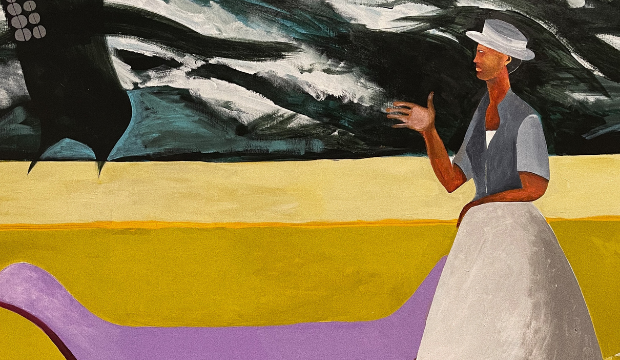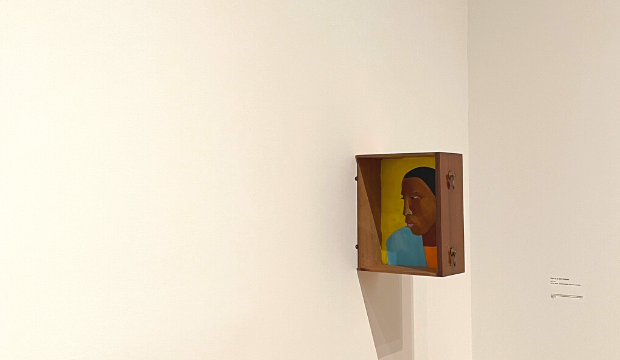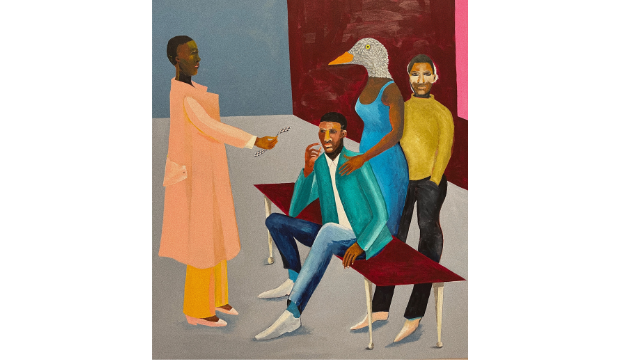Lubaina Himid exhibition, Tate Modern review ★★★★★
Tate Modern stages a major theatrical exhibition of work by the Turner Prize-winning artist Lubaina Himid
Credit: Lubaina Himid, Freedom and Change, 1984, Tate
Entering Lubaina Himid’s poetic world is mysteriously beguiling. Big, brightly coloured paintings, operatic soundtracks and questions asked on the walls: ‘What does love sound like?’, ‘What are monuments for?’… this exhibition doesn’t try to explain but leaves you to interpret and bring your answers instead.
For more than 30 years the painter, writer and curator Lubaina Himid has dedicated her multi-disciplinary practice to exploring questions of race, gender, class, overlooked histories and, more specifically, the trauma of the colonial past.
In this exhibition, her biggest show ever, the artist, who trained as a theatre designer, invites us to take part in a conversation around these themes. For a white, conscience-stricken reviewer like myself, it feels at first intimidating. But Himid’s ‘cultural activism’ is gentle and inclusive. It is not a slap in the face but an invitation to feel, to share, to understand.

The opening room explores architecture and the utopia of an ideal home. ‘We live in clothes, we live in buildings – do they fit us?’ Himid asks us. The theme is recurrent throughout the show. Some of her paintings are filled with imaginary and empty buildings; others depict characters going about their daily chores in a geometric decor – a woman is slicing lemons, some men are deep in conversation. The flat perspective brings the impression that they don’t really belong to the space they are in. How does one become the architect of one’s own life, how does one find home, I wonder.
In another room, Himid’s recent sound installation is perhaps a little hard to decipher. It certainly doesn’t have the same appeal and quiet power of her particularly moving portraits of young black men brushed into drawers.

In the final room, a series of absorbing paintings called the Rodeur – the name of a French slave ship where many African men and women were thrown overboard – feature elegant characters with inscrutable and impeccable composure. The sea, always nearly present in the frames, at time blue and peaceful, is more often sombre, unruly, threatening, a reminder of those forced and abominable journeys across the Atlantic Ocean.

‘I dream of a place to share,’ Lubaina Himid once wrote. ‘There are wooden balconies on the first floor behind which are spacious simple light rooms for sleeping and dreaming, talking and reconnecting while looking out to a warm blue ocean. I long for home but will never get there.’
A powerful exhibition, full of dreams, beauty and sadness.
The artist's background
Lubaina Himid has played a pivotal role in the British Black arts movement since the 80s, championing the work of underrepresented contemporaries at home and abroad. She says that her paintings, drawings, prints and installations seek to bring recognition to ‘the contribution black people have made to cultural life in Europe for the past several hundred years.’
Over the past decade, Himid has become a household name. In 2017, she won the Turner Prize and in 2018 she was awarded a CBE for her contribution to the arts. She has also been the subject of solo exhibitions at museums around the world, including The New Museum in New York, The Frans Hals Museum in The Netherlands and Spike Island in Bristol. In recent years, Himid’s work has seen a surge in demand at contemporary art fairs such as Art Basel.
For more than 30 years the painter, writer and curator Lubaina Himid has dedicated her multi-disciplinary practice to exploring questions of race, gender, class, overlooked histories and, more specifically, the trauma of the colonial past.
In this exhibition, her biggest show ever, the artist, who trained as a theatre designer, invites us to take part in a conversation around these themes. For a white, conscience-stricken reviewer like myself, it feels at first intimidating. But Himid’s ‘cultural activism’ is gentle and inclusive. It is not a slap in the face but an invitation to feel, to share, to understand.

The opening room explores architecture and the utopia of an ideal home. ‘We live in clothes, we live in buildings – do they fit us?’ Himid asks us. The theme is recurrent throughout the show. Some of her paintings are filled with imaginary and empty buildings; others depict characters going about their daily chores in a geometric decor – a woman is slicing lemons, some men are deep in conversation. The flat perspective brings the impression that they don’t really belong to the space they are in. How does one become the architect of one’s own life, how does one find home, I wonder.
In another room, Himid’s recent sound installation is perhaps a little hard to decipher. It certainly doesn’t have the same appeal and quiet power of her particularly moving portraits of young black men brushed into drawers.

In the final room, a series of absorbing paintings called the Rodeur – the name of a French slave ship where many African men and women were thrown overboard – feature elegant characters with inscrutable and impeccable composure. The sea, always nearly present in the frames, at time blue and peaceful, is more often sombre, unruly, threatening, a reminder of those forced and abominable journeys across the Atlantic Ocean.

‘I dream of a place to share,’ Lubaina Himid once wrote. ‘There are wooden balconies on the first floor behind which are spacious simple light rooms for sleeping and dreaming, talking and reconnecting while looking out to a warm blue ocean. I long for home but will never get there.’
A powerful exhibition, full of dreams, beauty and sadness.
The artist's background
Lubaina Himid has played a pivotal role in the British Black arts movement since the 80s, championing the work of underrepresented contemporaries at home and abroad. She says that her paintings, drawings, prints and installations seek to bring recognition to ‘the contribution black people have made to cultural life in Europe for the past several hundred years.’
Over the past decade, Himid has become a household name. In 2017, she won the Turner Prize and in 2018 she was awarded a CBE for her contribution to the arts. She has also been the subject of solo exhibitions at museums around the world, including The New Museum in New York, The Frans Hals Museum in The Netherlands and Spike Island in Bristol. In recent years, Himid’s work has seen a surge in demand at contemporary art fairs such as Art Basel.
TRY CULTURE WHISPER
Receive free tickets & insider tips to unlock the best of London — direct to your inbox
| What | Lubaina Himid exhibition, Tate Modern review |
| Where | Tate Modern, Bankside, London, SE1 9TG | MAP |
| Nearest tube | Waterloo (underground) |
| When |
24 Nov 21 – 22 May 22, Times vary |
| Price | £TBD |
| Website | Click here for more information and to book |